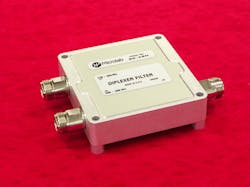Suitable for combining or separating WiFi and WiMAX signals in the 2.4- and 5-GHz bands, the model BK-28N diplexer has passbands of 2.400 to 3.800 GHz and 5.150 to 5.850 GHz. It provides better than 45-dB isolation between the bands. The passband insertion
loss is typically only 0.25 dB and a maximum of 0.50 dB. The diplexer can handle 20 W average power per band and features outstanding intermodulation distortion performance of better than -150 dBc (measured with 2 x 20-W carrier signals). It promises passive-intermodulation (PIM) performance of eve better, at -160 dBc. The component measures just 3.5 x 3.5 x 0.8 in. and weighs just 13 oz. (365 g) with Type N connectors. It is also available with SMA connectors. Microlab, a Wireless Telecom Group, Inc. company, 25 Eastmans Rd., Parsippany, NJ 07054; (973) 386-9696, (973) 386-9191, www.wtcom.com.
About the Author
Sign up for our eNewsletters
Get the latest news and updates
